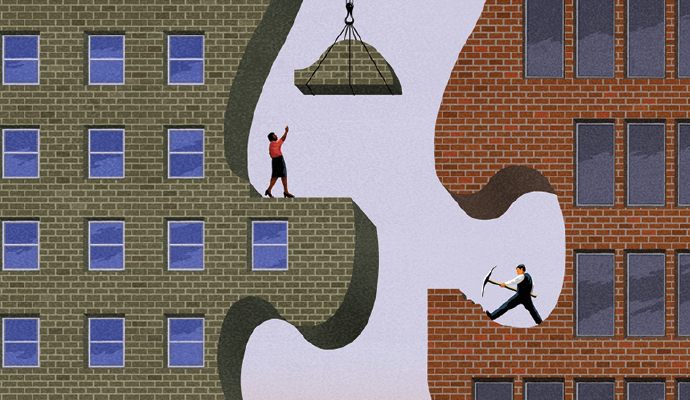How COVID-19 is reversing economies of scale
Technology was already pushing mass markets and production to become more personalized and distributed, and the novel coronavirus is accelerating the shift.
For more than a decade, new technologies such as cloud computing, artificial intelligence (AI), the Internet of Things (IoT), 3D printing, and blockchain have been taking apart the large-scale industries of the 20th century and reinventing them in ways that are more lightweight, personalized, distributed, and resilient. This “unscaling” trend has been inescapable in every sector, as Silicon Valley venture capitalist Hemant Taneja and I wrote in our book on the subject, Unscaled.
Social distancing and lockdowns amid the COVID-19 crisis have taken a tremendous toll on small businesses and employees, but they’ve also shifted the unscaling trend into a higher gear — which, we can all hope, will create new opportunities as the economy rebounds. We’re already witnessing the rapid reinvention of industries such as healthcare, education, and manufacturing, and a historical shift in the way we work.
As these unscaled realities take hold, mass markets and mass production will lose out to offerings that are hyper-focused and customized. For instance, online stores that learn your preferences are giving the one-size-fits-all giant retail store stiff competition and a reason to reinvent itself. Telehealth and IoT health trackers are remaking how doctor’s offices serve patients.
As unscaled realities take hold, mass markets and mass production will lose out to offerings that are hyper-focused and customized.
You can even see this customization happening now to businesses that were already small-scale. A successful bar, for instance, delivers an integrated combination of customer wants: a big place for gathering, people to socialize with, and booze. With social distancing, people are now creating their own distributed, personalized bars. We get together with our own friends on video, make our own cocktails just the way we want, and settle into chairs at home. The novel coronavirus has unscaled the bar. And even though the shift has come at a cost, it’s also opening the door for innovators — whether they be existing businesses trying to find new ways to reach customers or new entrants — to give us new ways to drink and socialize.
Here are some of the other ways this acceleration of unscaling is reinventing sectors in areas that would’ve been unexpected just six months ago.
Healthcare. Over the past few years, a new generation of health technology companies has started to unscale medicine by taking it out of hospitals and doctor’s offices and building it into AI software and mobile devices.
One example is Livongo, a company that has built treatments and tools to help people with diabetes and other chronic diseases manage their condition and stay out of the traditional healthcare system. For instance, the company produces a glucometer to record blood sugar readings that’s connected to interactive software that helps Livongo get to know each patient’s medical statistics. Artificial intelligence watches for patterns that suggest a developing problem, and guides the user to proactively handle it so it doesn’t get serious enough to require a doctor. Livongo users avoid the industry’s expensive, frustrating, mass-market approach to the disease in a way that’s simple to use, personal, and less costly.
Another company, Nuvo, provides pregnant women with a connected device that takes readings from outside the abdomen and sends the data back to AI-based software. The AI helps track maternal and fetal vitals so the user doesn’t have to go into a doctor’s office to do it. (And why would a young, healthy pregnant patient think it’s a good idea, post-pandemic, to drive to a hospital full of sick people for monitoring when she could do that at home?)
It had seemed like it would take five or 10 years for services like those offered by Livongo or Nuvo to have a profound unscaling effect on healthcare. But as hospitals have become overwhelmed by COVID-19 patients and doctor’s offices have abided by social distancing guidelines, the healthcare industry has had to rely on telehealth. And now, as we get used to this new way to get healthcare — much as we got used to streaming services as the new way to get movies and TV — virtual care is poised to go mainstream. There’s no going back.
Education. Companies that offer online classes, such as Khan Academy and Udacity, give students a way to learn at their own pace wherever they might be. Other services, such as ClassDojo, give teachers a way to interact with students and their parents outside of school hours. Such offerings have been unscaling education at the edges for the past decade.
But because of the novel coronavirus, millions of students have been sent home to learn. Many college students (and their parents) are now thinking twice about paying US$30,000 per semester in tuition, not only because they aren’t getting the same experience remotely that they’d get in person, but also because some of them are realizing it might be possible to get a more flexible college education in a less costly way. Many parents of young kids are realizing, too, that school can happen anywhere, anytime. Although parents, teachers, and kids miss many aspects of their traditional experiences, there might be better ways to learn than to force every student to be in class every school day.
Manufacturing. For a century, economies of scale drove manufacturing. The way to make the most money was to build a giant factory that would produce the same thing for the most people. In recent years, companies such as Amsterdam-based 3D Hubs have been proving out a different kind of manufacturing. 3D Hubs built a network of small 3D printing facilities so a product could be turned into software instructions, sent through the cloud to each facility, and made near customers in small batches. As 3D Hubs cofounder Bram de Zwart told me, “Why would you put a thousand machines in one place when you can put one machine in a thousand places?”
COVID-19 is helping prove his point. As cases have spiked, hospitals have been running out of key equipment, such as face shields and ventilators. Traditional factories haven’t been keeping up, and it’s been taking too long to retool plants set up to make cars or helmets so they can instead make healthcare equipment. Some 3D printing innovators have jumped in to help. A university lab in Hong Kong has created an open-source design for 3D-printed face shields. Irish entrepreneurs have been working on a 3D-printed ventilator. 3D Hubs set up a COVID-19 manufacturing fund to encourage more of the same sort of innovation, promising to use its network to build products near the hospitals that need them.
Although 3D printing isn’t set to widely displace traditional manufacturing yet, COVID-19 is turning into a proof point for how distributed, customizable, flexible manufacturing can better react to shifts in the market and produce and distribute some goods faster than old-school factories.
Commercial real estate. An enormous swath of the global workforce has been told to stay out of the office and work from home. The tools are all in place to unscale the office and make it virtual: software and data in the cloud, broadband at home, good videoconferencing for meetings. Many companies are finding work can continue with a distributed office. Workers are getting a sense of life without long commutes and inflexible hours. As the coronavirus crisis eases, how much of the workforce is going to remain virtual, at least some of the time? “This might be a chance for a great reset in terms of how we work,” wrote Matt Mullenweg, chief executive of WordPress and Tumblr’s parent company, Automattic, in his blog. The old idea that a company wasn’t a company without an office might be over.
Of course, it’s very human to want to gather together in a physical space, and no doubt that desire will be there as governments lift COVID-19 restrictions. Sometimes we need a doctor in person, or want the added value of connecting with other students on a campus. Bars won’t go empty, either — we’ll return to meeting in crowded, noisy places where it takes 20 minutes to get a bartender to make you a $15 cocktail. Yet some of the unscaled, flexible, personalized versions of these and other services are sure to become prominent enough in the post-COVID-19 era to alter enormous industries. And hopefully those solutions will help the businesses and people of the world survive this trying time and come through it changed for the better.
Meet you on Zoom and we can drink to that.






